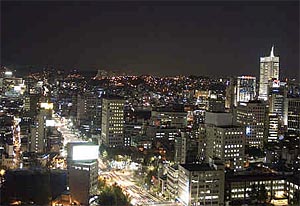 The smart grid is an information revolution for utilities, and the first source of that information is smart meters. A smart meter records consumption of electricity in intervals of an hour or less and communicates that information back to the utility.
The smart grid is an information revolution for utilities, and the first source of that information is smart meters. A smart meter records consumption of electricity in intervals of an hour or less and communicates that information back to the utility.
EMeter provides metering data management products to utilities. I talked to Aaron DeYonker, global head of product management at eMeter, about how data will transform the way utilities do business. Our interview follows.
How much new data do utilities have to process because of smart metering?
Aaron DeYonker: Currently, most utilities do a standard meter read once a month. With smart meters, utilities have to process data at 15-minute intervals. This is about a 3,000-fold increase in daily data processing for a utility, and it’s just the first wave of the data deluge. The second wave will include granular data from smart appliances, electric vehicles and other metering points throughout the grid. That will exponentially increase the amount of data being generated.
What processes do utilities have to change to deal with the data?
Aaron DeYonker: Utilities tend to be risk adverse and as a result may not have utilized technology for internal business process as much as other industries like telco or banking. Coupled with growing energy demands, utilities need to change a number of business processes beyond billing to handle the amount and type of data they now manage. Outage management, customer service, load research and wholesale electricity market transactions — where utilities buy and sell electricity to each other — are just a few of the impacted areas.
In the case of power outage management, for example, the traditional business process relied on processing customer calls to detect outage hotspots. Now, smart meters can automatically report that they have lost power. That enables more proactive dispatching of resources to fix problems. However, the data needs to be collected, validated and processed quickly to make resolution times as fast as possible. So utilities now need to develop new business processes to enable this.
 Strata Conference New York 2011, being held Sept. 22-23, covers the latest and best tools and technologies for data science — from gathering, cleaning, analyzing, and storing data to communicating data intelligence effectively.
Strata Conference New York 2011, being held Sept. 22-23, covers the latest and best tools and technologies for data science — from gathering, cleaning, analyzing, and storing data to communicating data intelligence effectively.
Beyond billing, how can utilities put metering data to use?
Aaron DeYonker: The list is endless, but here are a few use cases: customer service, outage management, conservation and efficiency programs, demand response (reducing consumption at peak demand times), demand forecasting, energy “theft” detection, “line-loss” detection, new product offerings (including new rates for electric vehicles and renewables), and peak-load reduction programs.
Let’s take customer service as a specific example. Many utility call centers deal with routine complaints about high bills. Customers can now get notifications that a spike in usage has been detected and the data might even be able to pinpoint the actual culprit within the home, such as an aggressively programmed air conditioner. Alerting the customer before the bill arrives will reduce call volumes and increase customer satisfaction.
What actionable metrics or alerts can you derive from meter data?
Aaron DeYonker: Having access to more detailed data opens the door to setting more accurate metrics, both for the utility and the consumer. With the right data, utilities can better diagnose outages as close to real time as possible and allocate resources as quickly and effectively as possible to resolve problems.The meters will send these events up and the system needs to perform powerful and fast analysis to distinguish true problems from false alarms.
On the business side, many utilities look for ways to reduce the peak demand for energy, which typically occurs in the afternoon and evening during the summer. Programs that have cheaper night-time rates are now possible because metering data is gathered at regular intervals. Measuring the effect of these rates on customer behavior is critical in lobbying regulatory bodies to approve these programs for broader roll out.
In addition, consumers are empowered to regulate their own energy use. That helps reduce unnecessary energy usage and generation. In some jurisdictions, the metering data will in fact eliminate the need for new nuclear power plants based on the expected efficiencies derived from smarter pricing.
How do you see utilities using metering data in the future?
Aaron DeYonker: At the very least, flattening out the daily demand curve will have incalculable benefits on our overall energy infrastructure as demand increases. The use of metering data enables a limitless potential for new products and services for utilities and their customers. Armed with a rich dataset on par with that of the financial services and telco industries, utility companies can model, forecast and prototype with much more power and precision. It’s impossible to envision the extent to which this data is applied to future innovations, but it will be extensive and world changing.
This interview was edited and condensed.
Photo: Seoul by night by Koshyk, on Flickr
Related:
